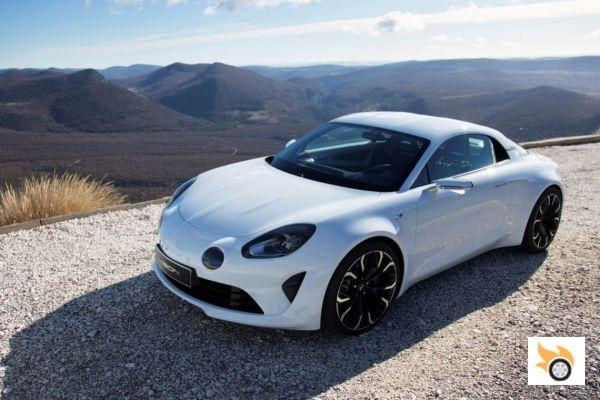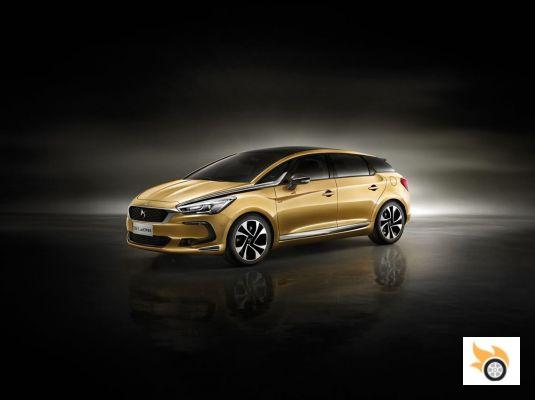So why should France be any different? After all, it is the birthplace of the most famous brands of all kinds of luxury goods, such as Chanel, Louis Vuitton, Hermés or Cartier. Paris is the birthplace of haute couture, responsible for dressing the most elegant women in the world. It is also a true mecca for sybarites, always on the lookout for Michelin stars or the best Bordeaux red wine or the best cognac. As if that weren't enough, the Cote D'Azur is an international haven for celebrities, tycoons, sheiks and royalty, boasting the highest concentration of millionaires in the world.
Yes sir, no doubt the French are lovers of glamour and what they call savoir vivre. And don't tell me that this quest for excellence has been limited to consumer products, because France is also home to prestigious manufacturers of luxury yachts and executive jets such as Beneteau and Dassault respectively. In particular, let's remember that on French soil was born (and unfortunately also died) the famous Concorde, a technological marvel that still amazes aviation lovers today.
And so, why is it that today all this illustrious heritage is not adequately reflected in its automotive industry? Please don't get me wrong, I love French cars and I truly believe they have reached great heights in technology, design and quality; it's just that something else is missing that, however good, a Peugeot, Citroën or Renault can't offer.
However, it wasn't always like that. In the first half of the last century, there were several French luxury car manufacturers that rubbed shoulders with the best in the world, with brands such as Delage and Talbot-Lago standing out. The first one had an illustrious history with competition cars, producing different models whose maximum expression was the Delage D8, powered by an in-line eight-cylinder engine of more than four liters, the first one developed by the French industry. For its part, Talbot-Lago developed a line of voitures de sport that competed successfully with the Alfa Romeos, Ferraris and Bentleys of the time in several grand prix and the 24 Hours of Le Mans; the firm also produced large coupes and sedans that were among the most luxurious and fastest cars of their time.
Both manufacturers maintained a traditional approach to their operations, producing chassis that were then finished by various Gallic carrossiers including Letourneur et Marchand, Chapron, Figoni et Falaschi, Pourtout and Saoutchik, responsible for some of the most elegant and daring designs the world has ever seen. Later, Talbot-Lago introduced models with their own designs such as the T-26 Record. One need only look at a Delage D8-120 S Portout Aerodynamic Coupé or a Talbot-Lago T150-C SS Teardop (Goutte d'Eau) Coupé to see that these cars were true works of art aimed at an exclusive audience. It is said that many stars of the time such as Marlene Dietrich and Christian Dior as well as presidents of the French Republic owned these cars. Of course, if none of these models satisfied the tastes of such a refined clientele, there was always Automobiles Ettore Bugatti?
The turning point
At the end of the Second World War and with the economy in ruins, the French State (which still had a long tradition of intervention in industry) established a programme of austerity and rigid control of the country's factories under the new doctrine of dirigisme. Faced with a critical shortage of supplies (including precious steel) it was decided that too many independent brands were operating in the automotive sector and that consolidation was necessary, with a small group of manufacturers being favoured and concentrating their production on low-cost cars. In addition, very high taxes were imposed on the purchase of high displacement models. This situation, coupled with a demand weakened by the difficult post-war economic situation, ended up leading to the ruin of luxury car brands in France and by the end of the 50s there were only four major manufacturers: Citroen, Peugeot, Renault and the now defunct Simca.
Renault was nationalized after the war because of its collaborationist nature with the Third Reich.
In this context, I can not fail to mention the Facel Vega, a line of sophisticated grand routiers manufactured in limited quantities from 1954 following the best of French tradition. These coupes, with hand-finished bodywork, aircraft-style interiors trimmed in English leather and powered by powerful Chrysler V8 engines, were once more expensive than a Maserati 3500 or an Aston Martin DB4. With such quality craftsmanship it's no wonder they found favour with many celebrities, from Hollywood celebrities like Ava Gardner to Formula 1 drivers like Stirling Moss; even Ringo Starr and Pablo Picasso owned one. Unfortunately, despite the initial success, ten years after it began, the production had to be abandoned.
A little later, the Citroen SM (for Série Maserati) arrived on the market, an avant-garde and aerodynamic 2+2 coupé almost five metres long, the result of a collaboration with the Italian carmaker. It was a front-wheel drive car powered by an aluminium V6 engine - of Maserati origin - which also featured the revolutionary hydropneumatic suspension, variable and self-centring power-assisted steering, four-wheel disc brakes and directional headlights. Despite its advanced technology, the SM failed to carve out a significant niche for itself among potential buyers who preferred more classic designs such as a BMW 3.0 CS. All this investment in the development of new technologies took its toll on Citroen's financial solvency and in 1976 it was taken over by Peugeot to form PSA.
Apart from the notable exceptions noted above, French manufacturers have long abandoned the premium segment. True, more recently there have been efforts to get a slice of such a lucrative market with breakthrough cars like the Renault Avantime and Vel Satis, but they certainly haven't been very successful. In fact, the low sales of the Avantime were responsible for Matra, the Renault subsidiary responsible for the project, abandoning car manufacturing for good. Nowadays even the Japanese themselves are more relevant with their brands Infiniti and -above all- Lexus.
It seems that the French carmakers have finally convinced themselves that in order to have a real chance of success in the premium market, it is necessary to do so with exclusive dedicated brands. Indeed, in 2014 PSA announced the establishment of DS as the group's new Premium brand, while its neighbor Renault, in a project initially shared with the English Caterham, is about to launch a reissue of its former sports car brand Alpine.
Initially created to identify high-end Citroens, DS (pronounced déssse or goddess in French) was named after the iconic eponymous model produced by the French house between 1955 and 1975. As was already characteristic of the brand, the DS stood out for its innovative technical and design qualities, being the first car developed with hydropneumatic suspension on all four wheels. A true work of industrial art, its technical prowess was demonstrated by victories in rally competitions in Finland and Monte Carlo.
It is not for nothing that the Citroen DS took third place in the "Car of the Century" award, ahead of icons such as the Volkswagen Beetle and the Porsche 911 (for the curious, the winner was the Ford Model T). Today, the range of the new DS Automobiles continues to be based on Citroen models sharing body styles and most of the engines. However, from 2018, if all goes according to plan, more differentiated models with new technologies (hybrid propulsion, autonomous driving, 4WD...) and an avant garde style worthy of the French heritage will start to be launched.
The strategy followed by the Régie is very different as it seeks the rebirth of Alpine, the legendary brand of sports cars developed from Renault engines. From the first car produced in 1955, the tiny A106, a series of models were developed that performed brilliantly in numerous rally competitions, including the Coupe des Alpes from which the brand's name derives. Feared rivals of the Lancias and Porsches, all Alpine models had in common compact fiberglass bodywork, austere interiors, rear-wheel drive and low displacement rear engines and Renault origin; although it is true that the last ones moved away a little from this successful formula by having larger dimensions and incorporating more equipment and V6 engines.
The most emblematic car of the firm is undoubtedly the A110 that was manufactured between 1961 and 1978. The Alpine brand, which had been acquired by Renault in 1974, remained on the market until 1995 when the last A610 rolled off the production line; from then on the Dieppe factory was dedicated to producing Renault Sport models. Twenty years later Carlos Ghosn, current president and CEO of Renault, has presented in Monte Carlo the Alpine Vision prototype of the new model that will be launched next year with an eye on the Porsche 718 Cayman.

Introducing (or in Renault's case reintroducing) a new brand in today's market is a challenging task to say the least. Investments in the development of new technologies and designs can be staggeringly high, not to mention the marketing effort to properly position the brand, something especially critical in the premium segment. This can be even more difficult when you consider that new generations may not be very aware of the historical heritage you want to evoke. After all, it has taken Audi at least 15 years to achieve worldwide recognition as a premium manufacturer.
In today's competitive and globalized market, even the (seemingly unbeatable) Germans can't rest on their laurels. In addition to the French manufacturers, others are also making great efforts to expand their space in the premium market. In North America, Cadillac and Lincoln are looking to reinvent themselves, while the Swedes at Volvo want to raise their brand image at all costs; in Italy, Alfa Romeo and Maserati are expanding their range in search of new customers and so are Jaguar and Land Rover in the UK. Even the Koreans want to get involved with their new prestige brand Genesis.
In my opinion, the strategy followed by PSA in trying to pick up a valuable design and technology heritage with DS is the right one. However, I'm still not convinced of its implementation because since its initial conception as a DS sub-brand it has been closely associated with Citroen, which also produces economy cars. First impressions count, and a lot. If the next models don't offer significant differentiation in design, technology and quality the young brand risks being pigeonholed indefinitely as a high-end Citroen and not as a genuine competitor to Volvo, Audi or BMW.

In the case of Renault I see the situation a bit clearer. The Alpine brand has a unique technical heritage and a strong identity that should be well received among sports car lovers, even if the brand is not so well known outside France. The prototype presented in Monte Carlo, painted in bleu de france, certainly looks like a worthy heir to the Berlinettes of days gone by. In addition, the new Automobiles Alpine could extend its reach into other segments of greater volume that will allow it to grow in the future; in fact there is already talk of developing a sports SUV to compete with the Porsche Macan. Sacrilege? It may seem so to some, but the strategy has worked very well for Porsche and, more recently, Jaguar. In this case, the challenge will be to keep the brand's DNA intact without diluting its historic appeal.
In the end, time will tell if this crusade to regain even a part of the lost glory in a market saturated with competitors is successful. But what is certain is that the coming years will be very exciting for the French car industry, which deserves to have a prominent place alongside the best brands in the world.

























